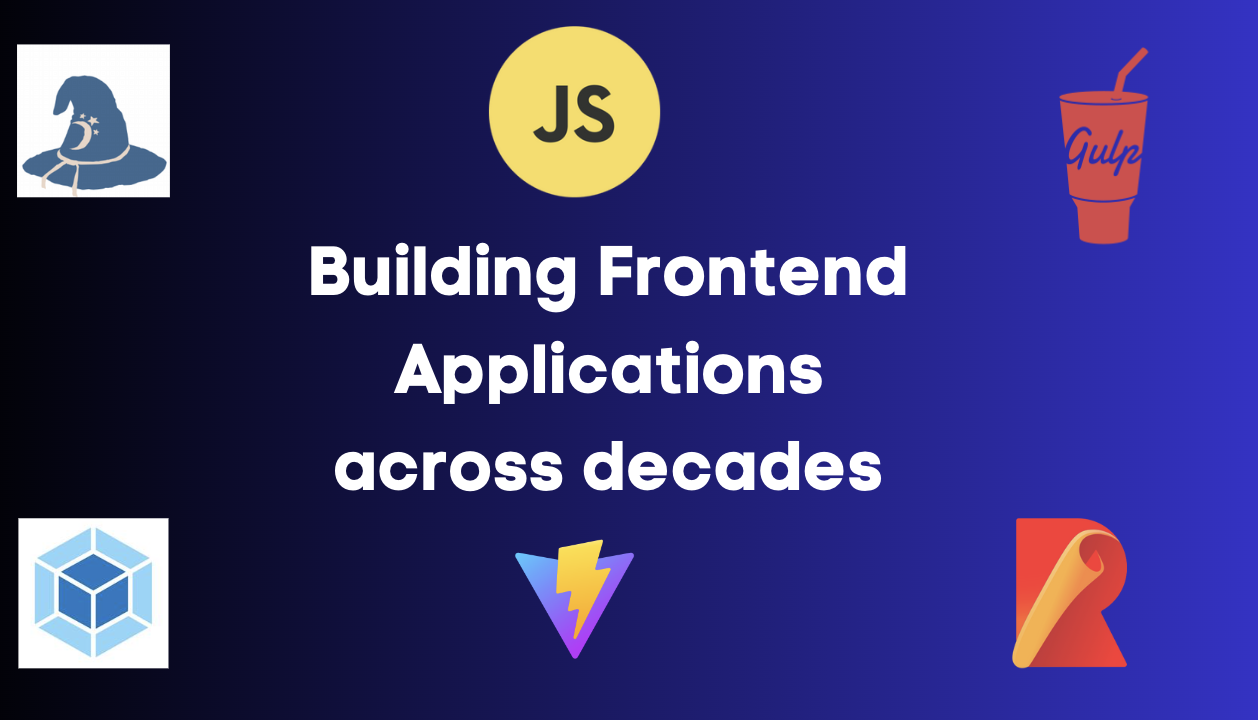Building Frontend Applications across decades
 Ayman Patel
Ayman PatelTable of contents

Building your Frontend applications is not the same, and will not be the same. Here we will go chapter-wise on how the whole frontend bundling experience is like
Chapter 1: YOLOing
<script>tags all the way downChapter 2: The Original "G"s : Grunt and Gulp Task Runner
Intermission 1: JS Standards and rise of transpilers and Parsers
Chapter 3: Forgotten in time; Bower and Browserify
Chapter 4: Module Bundlers Mashups (Webpack, Rollup and Parcel)
Intermission 2: Make JS Blazingly fast by not using JS (Esbuild, SWC)
Chapter 5: Rising stars; Rspack, Vite and Turbopack
Chapter 1: YOLOing <script> tags all the way down
script tags as UI bundling with YOLOing the prod UI bundle
Consider a situation where you are improving JS scripts from a CDN using the script tag. You have a main library like jQuery which has all helper methods for manipulating DOM, AJAX calls etc. For some reason, there is another library that is meant for improving async AJAX calls. Let us call it ajax-plugin.js. Since jQuery already comes with AJAX, the ajax-plugin overides this behaviour. But since the plugin library did not consider that your were using the same function name as jQuery; hence you find an issue making both of them work. Example can be seen in the following Replit project;
Here in index_script_overide.html, we have loaded the scripts like this:
<script src="https://code.jquery.com/jquery-3.6.0.min.js"></script>
<script src="ajax-plugin.js"></script> <!-- Include the custom plugin -->
When you run this, you can see the jQuery loads before the culprit JS file ajax-plugin.js that overides the ajax function of jQuery; which creates a Maximum Stack error:
In index.html, jQuery is loaded at the end;
<script src="ajax-plugin.js"></script> <!-- Include the custom plugin -->
<script src="https://code.jquery.com/jquery-3.6.0.min.js"></script>
This will work, but the solution is YOLO (You Only Live Once) as a production grade application's script dependencies is a cobbled web which will be impossible to untangle.
Hence, ordering matters in script imports for Javascript files which is a big headache if done manually. Hence, there needed to be a solution that made sure that these type of issues do not come.
Chapter 2: The Original "G"s : Grunt and Gulp Task Runner
Grunt Gulp galore gangsters
Grunt
\==demo not possible; provide psedo code==
Gruntfile.js
module.exports = function(grunt) {
// 1. Project configuration
grunt.initConfig({
// Tasks configuration
concat: {
options: {
separator: ';',
},
dist: {
src: ['src/*.js'],
dest: 'dist/bundle.js',
},
},
uglify: {
dist: {
files: {
'dist/bundle.min.js': ['<%= concat.dist.dest %>'],
},
},
},
watch: {
scripts: {
files: ['src/*.js'],
tasks: ['concat', 'uglify'],
options: {
spawn: false,
},
},
},
});
// 2. Load plugins
grunt.loadNpmTasks('grunt-contrib-concat');
grunt.loadNpmTasks('grunt-contrib-uglify');
grunt.loadNpmTasks('grunt-contrib-watch');
// 3. Register task(s)
grunt.registerTask('default', ['concat', 'uglify', 'watch']);
};
Gulp
gulpfile.js
const gulp = require('gulp');
const concat = require('gulp-concat');
const uglify = require('gulp-uglify');
const rename = require('gulp-rename');
// TODO: Add task for browserify
// Concatenate and minify JavaScript files
gulp.task('scripts', function() {
return gulp.src('src/*.js')
.pipe(concat('bundle.js'))
.pipe(gulp.dest('dist'))
.pipe(rename('bundle.min.js'))
.pipe(uglify())
.pipe(gulp.dest('dist'));
});
// Watch for changes in JavaScript files
gulp.task('watch', function() {
gulp.watch('src/*.js', gulp.series('scripts'));
});
// Default task
gulp.task('default', gulp.series('scripts', 'watch'));
Task runner lead to Big Ball of Mud with no good abstractions on how to load a JS and CSS. It was all custom scripts which were brittle and hard to extend. That is why tools such as Rollup and Webpack came and became dominant in building JS applications!
Intermission: JS Standards and rise of transpilers and Parsers
IE deviation, ES6 migration and dread of polyfills
ES6 Migration and the Need for Babel
With the evolution of JavaScript, ECMAScript 6 (ES6), introduced significant enhancements to the language, providing developers with powerful features to write more concise, readable, and maintainable code. However, the widespread adoption of ES6 posed a challenge for developers, particularly those working on projects with existing codebases or targeting older browsers such as IE11 that lacked support for ES6 features out-of-the-box.
To address this compatibility issue, developers turned to transpilers like Babel. This converted non-ES6 code into ES6 with help of polyfills
Chapter 3: Forgotten in time
You will be remembered for your service:
Bower
Browserify
Bower
It was released in early 2010s (around 2012). Node.js was 3 years old in 2009 and npm was released in 2010. JS import such as CommonJS were becoming the standard on server-side Node.js. Frontend world were not reaping the benefit of a package manager like NPM and CommonJS.
Bower solved these 2 problems. It created things:
A package manager that works on the web.
Making CommonJS work on the web
Package Manager
When you install frontend packages in Bower it would go to bower_components folder (not the usual node_modules folder which is the norm now!)
RequireJS
Bower folder structure
bower_project/
├── bower_components/
│ ├── package1/
│ │ ├── dist/
│ │ ├── src/
│ │ └── bower.json
│ ├── package2/
│ │ ├── dist/
│ │ ├── src/
│ │ └── bower.json
│ └── ...
├── build/
├── src/
├── bower.json
└── .bowerrc
Downfall of Bower was its own usage of modules folder. Also NPM picked up support for module resolution and usage of frontend libraries which eventually made Bower useless.
Browserify
It is a spiritual successor to Bower. It didn't create its own Package manager but allowed to write CommonJS imports on the browser.
Browserify allowed Node-speicfic library packages such as events, stream, path, url, assert, buffer, util, querystring, http, vm, and crypto into the browser.
The architecture of Browserify did not consider features such as
Multiple entry points per-page
ES Modules as Browserify was built on making Node's CommonJS available to browser
Chapter 4: Module Bundlers Mashups
Fourth way of building UI (after Yolo Scripts, Task Runners and Third wave building tools)
Webpack
Rollup
Parcel
Webpack
This is the tool I have worked with the most. But even Webpack teaches me something new when I back to it!
Core Strength: Plugin ecosystem.
Webpack is the defacto Module bundler for frontend applications. Angular uses it under the hood. Create-React-App uses Webpack which can be modifiend when you run the npm run eject command.
Webpack was created in mid-2010s to solve the issue of Big-ball of mud codebases that were created when using task runners such as Gulp and Grunt. It uses a better abstraction model of using plugins and loaders for trasnpiling source code into production build. It also provided a webpack-dev-server which just works without manually configuring like it used to be in Grunt via watch mode
Webpack Example:
Rollup
Second-place in popularity and maturity. It has a rich ecosystem of APIs to hook into, which is why Vue uses it for its production build.
Parcel
Less popular than Rollup and Webpack but still used today.
Intermission 2: Make JS Blazingly fast by not using JS
Before we go to the final section of modern modern bundlers, we need to talk about what improvementsare being done in ther JS ecosystem. It is all about reduing bloat that were used in the past due to differfent browser suppot, usage of lighter and fast runtimes such as Rust, Golang, Zig etc
A Logan would say;

ESBuild
Go based bundler that is faster than Webpack, Rollup and Parcel
It is used in Vite in the pre-bundling process.
SWC
Rust based Babel alternative Used by Next.js, Parcel and Deno. Next.js uses SWC for 2 things:
Replacement of Babel for transpiling Typescript to Javascript
Replacement for TerserPlugin (Minifies JS for smaller bundle sizes)
In the following simple Hello World React + Typescript example, you can see the performance improvements of using SWC and ESBuild
| Tool | Time | Speed difference |
| tsc | 15.77s | base |
| swc | 2.85s | 5.5 times faster than tsc |
| esbuild | 1.68s | 9 times faster than tsc |
Vite
Fast module bundler that combines all the great modern browser featres
Vite is a amalgamation of a lot of modern JS technologies such as Esbuild, Rollup, ES Modules
Blazingly fast Dev Mode
Levereges ESBuild and ES Modules to make vite HMR (aka Livereloading) blazingly fast
- ESBuild usage in Vite:
Vite uses ESBuild for pre-bundling node_modules dependencies. 2. ES Modules usage in Vite: Vite uses ESM do development code inside project.
Vite Local Start -> Esbuild for libraries -> ESModule for local project files -> Browser
Blazingly fast Prod build
Leverages Rollup to make builds faster. There are plans by Vite to create its own bundler Rolldown in the future.
Blazingly fast Test execution
Vite ecosystem provides a Jest compatible Vitest for running Unit test cases faster.
Vite example:
Turbopack
Vercel'answer to build tools with blazingly fasst builds for Next.js, Svelete and other Vercel-supported platforms
Rspack
Blazingly fast Webpack written in Rust @ Bytedance
Subscribe to my newsletter
Read articles from Ayman Patel directly inside your inbox. Subscribe to the newsletter, and don't miss out.
Written by

Ayman Patel
Ayman Patel
Developer who sees beyond the hype